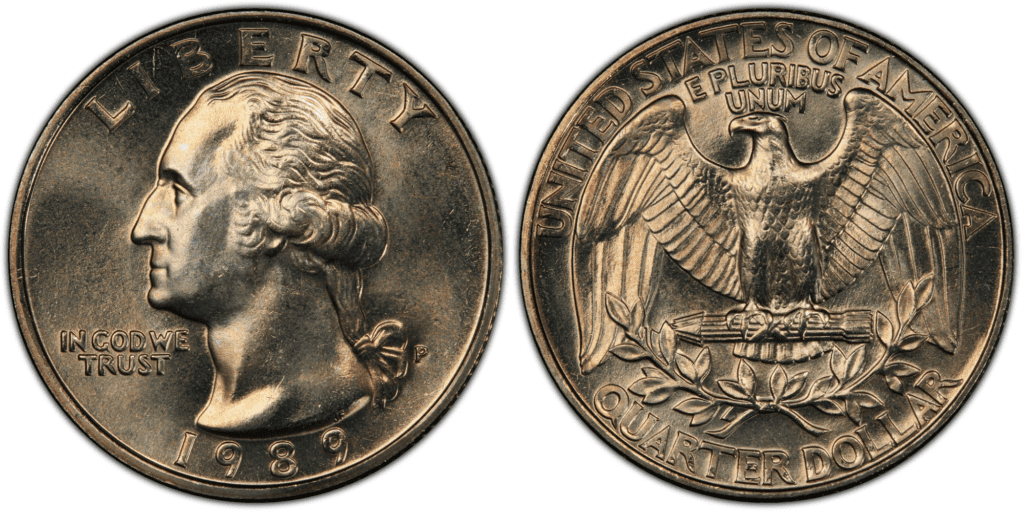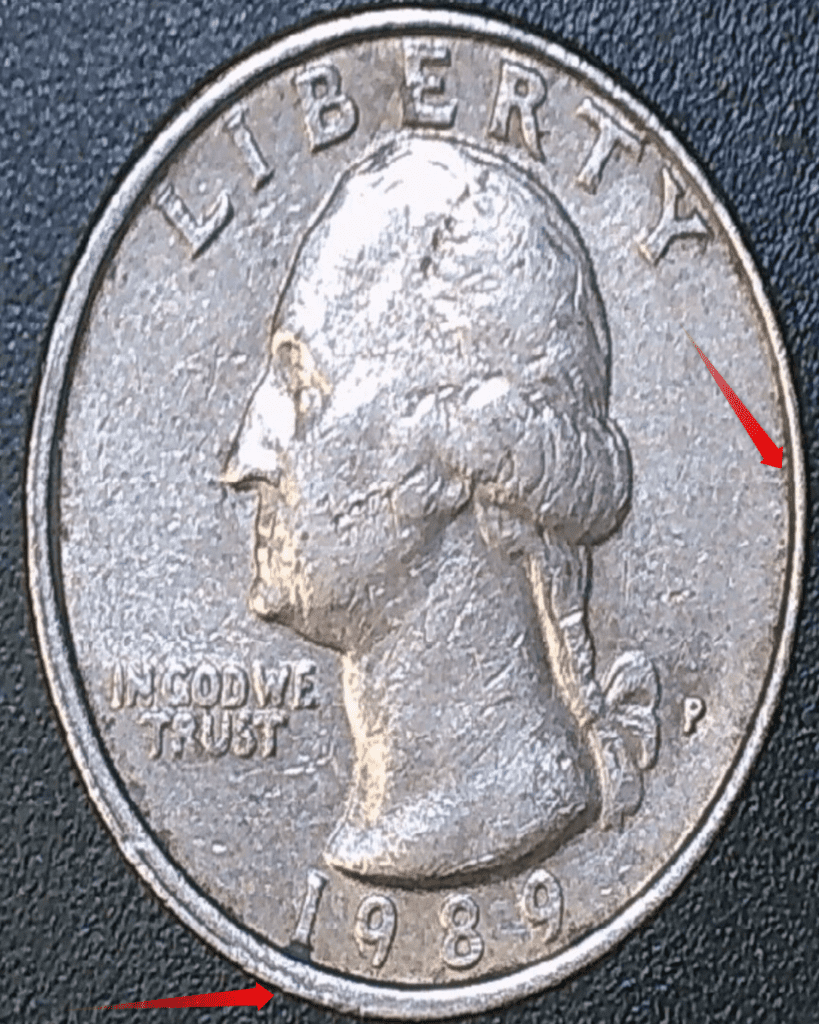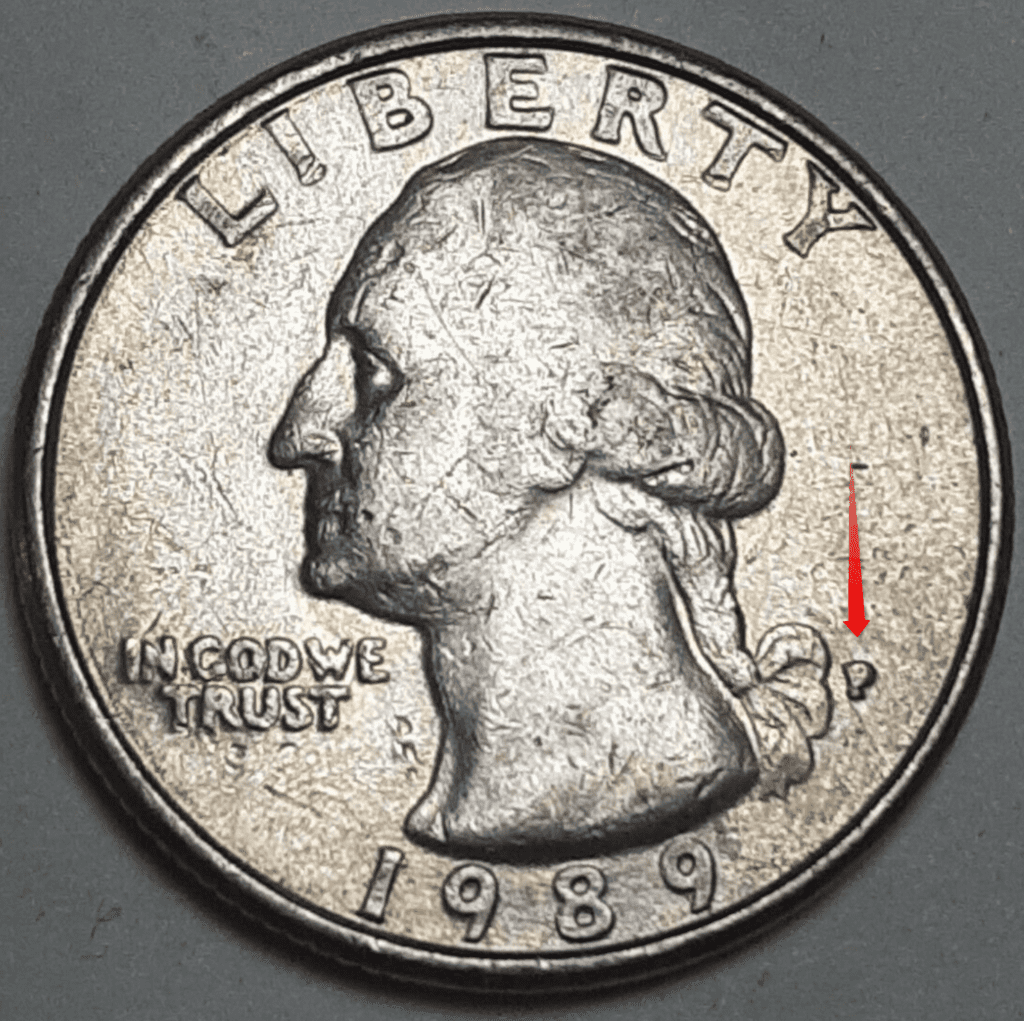What Is the 1989 Washington Quarter Made Of?
The 1989 Washington quarter is made of 91.67% Copper and 8.33% Nickel. It is a coin that is cupro nickel clad to copper. This means that it has a pure copper core and is covered with a portion of nickel.
The Washington quarter wasn’t always made of copper. Prior to 1965, the Washington quarter was made of 90% silver and 10% copper.
The Washington quarter of the year 1989 has a face value of 25 cents. It has the following specifications:
- Mass of 5.67 grams
- Diameter of 24.3 millimeters
- Reeded edge
- Thickness of 1.75 millimeters

photo source: PCGS
When it comes to the obverse design, the 1989 quarter has the left profile of George Washington who served as the first president of the United States. John Flanagan designed the original version of the Washington quarter. Other inscriptions included on the obverse are the following:
- LIBERTY
- IN GOD WE TRUST
- 1989
- Mint mark (if present, can be D, S, or P)
On the reverse side, you will find the bald eagle with its wings outspread. The eagle clasps arrows on its talons. Under the arrow are two olive trees. The arrows symbolize preparedness to defend the country. The olive branches represent peace and friendship.
Inscriptions include the following:
- UNITED STATES OF AMERICA
- E PLURIBUS UNUM
- QUARTER DOLLAR
The first Washington quarter was struck in 1932, which was the same year of the bicentennial birth of George Washington. Initially, the bicentennial committee wanted to have a Washington half-dollar. However, the quarter coin was chosen instead, removing the Walking Liberty image from the 25-cent coin.
1989 Washington Quarter Varieties
The 1989 Washington quarter comes in different varieties. Most differences would include the mint mark. Some also become a different variety due to errors made during the minting process.
Here are some of the 1989 Washington quarter that you should know.
1989 D Washington Quarter
Year of minting: 1989
Mint Mark: D
Place of minting: Denver
Quantity produced: 896,535,597
Face Value: $0.25 (twenty-five cent)
Price: $0.30 to $0.85 (or more)
Mass: 5.67 grams
Edge: Reeded
Designer: John Flanagan
Composition: 91.67% Copper and 8.33% Nickel
Diameter: 24.3 millimeters
Thickness: 1.75 millimeters

photo source: USA Coin Book
The 1989 D Washington quarter was made in the Denver Mint. By the end of 1989, there were almost 900 million of these coins produced. The circulated 1989 D Washington quarter is priced at around $0.30 to $0.85. However, uncirculated and beautiful 1989 D quarters can be as expensive as $625 in the open market.
1989 P Washington Quarter
Year of minting: 1989
Mint Mark: no mint mark (P if the mint mark is present)
Place of minting: Philadelphia
Quantity produced: 512,868,000
Face Value: $0.25 (twenty-five cent)
Price: $0.30 to $0.85 (or more)
Mass: 5.67 grams
Edge: Reeded
Designer: John Flanagan
Composition: 91.67% Copper and 8.33% Nickel
Diameter: 24.3 millimeters
Thickness: 1.75 millimeters

photo source: USA Coin Book
The 1989 P Washington quarter can be bought for as much as $465 in the open market. However, circulated varieties can only be about $0.30 to $0.85. There were more than 500 million of these coins produced by the Philadelphia Mint.
1989 S Washington Quarter
Year of minting: 1989
Mint Mark: S
Place of minting: San Francisco
Quantity produced: 3,220,194
Face Value: $0.25 (twenty-five cent)
Price: $0.30 to $4.52 (or more)
Mass: 5.67 grams
Edge: Reeded
Designer: John Flanagan
Composition: 91.67% Copper and 8.33% Nickel
Diameter: 24.3 millimeters
Thickness: 1.75 millimeters

photo source: USA Coin Book
The San Francisco Mint specialized in producing proof coins, which involved a more time-consuming and meticulous process. Thus, it is not surprising that only about 3 million of 1989-S Washington quarters were produced.
Proof coins have a higher eye appeal level compared to coins made in other minting centers. They are polished manually and come with a higher level of detail. If you have a 1989 quarter-proof coin, you can sell it for as much as $4.52.
List Of 1989 Washington Quarter Errors
The minting process of the 1989 Washington quarter wasn’t always perfect. That’s why you’ll find some coins that come with errors.
Here are some examples:
1989 P Washington Quarter Error Die Chip

photo source: eBay
Because of the die error, you’ll find a small dot right in front of Washington’s face.
1989-P Washington Quarter Misaligned Strike Error Coin

photo source: eBay
Misalignment caused the strike to be off-center. As you can see in the image above, the right side edge of the coin is narrower compared to the lower right corner.
1989 P Quarter Filled In Mintmark

photo source: eBay
The mint mark, P, isn’t as clear as it should be. Instead, the P is filled and it isn’t as detailed as it should be.
1989 D Washington Quarter with Double “D” Mint Error

photo source: ebay
The D mint mark was struck twice. Thus, it looks like there’s a doubling of the letter’s edge.
How Much Is 1989 Washington Quarter Worth Today?
The 1989 Washington quarter can be bought and sold for around $0.30 to $1.00. Its melt value is just $0.0497. So, either way, the 1989 Washington quarter isn’t that expensive. This is good news to the buyers, but bad news to the sellers.
As this might be the case, if you have an uncirculated 1989 quarter in a pristine condition, then you can earn more money from it. Based on the previous records in the open market, you can sell highly graded 1989 Washington quarters for $400 to $600.
Here’s a comparison table of the pricing of 1989 Washington quarters based on their variety and grade:
| Coin | Condition | Grade | Mintage | Value |
| 1989 D Washington Quarter | Circulated/mint | Not graded | 896,535,597 | $0.30 to $0.85 |
| 1989 P Washington Quarter | Circulated/mint | Not graded | 512,868,000 | $0.30 to $0.85 |
| 1989 S Washington Quarter | Circulated/proof | Not graded | 3,220,194 | $0.30 to $0.85 |
| 1989 D Washington Quarter | Uncirculated/mint | MS-65 | 896,535,597 | $15 |
| 1989 P Washington Quarter | Uncirculated/mint | MS-65 | 512,868,000 | $13 |
| 1989 S Washington Quarter | Uncirculated/proof | PR-65 | 3,220,194 | $4.52 |
| 1989 D Washington Quarter | Uncirculated/mint | MS-66 | 896,535,597 | $25 |
| 1989 P Washington Quarter | Uncirculated/mint | MS-66 | 512,868,000 | $35 |
| 1989 S Washington Quarter | Uncirculated/proof | PR-69 | 3,220,194 | $18.75 |
| 1989 D Washington Quarter | Uncirculated/mint | MS-67 | 896,535,597 | $625 |
| 1989 P Washington Quarter | Uncirculated/mint | MS-67 | 512,868,000 | $465 |
| 1989 S Washington Quarter | Uncirculated/proof | PR-70 | 3,220,194 | $70 |
How Does The Grading System Work?
The Sheldon Scale is used by numismatists to provide a numerical value to coins. The Sheldon Scale goes from poor (P-1) to perfect mint state (P-1) (MS-70). Coins were originally evaluated using words to reflect their condition (Good, Fair, Excellent, Etc.). Unfortunately, coin collectors and dealers had different ideas about what each of these terms represent.
Professional numismatists joined together in the 1970s and established CoinGrading standards. These numismatists now assign grades at key places on the seventy-point scale, using the most regularly utilized numeric points in conjunction with the original adjective grade. The following are the most common coin grades:
-
-
- (P-1) Poor – Indistinguishable and probably damaged; if used, must have a date and mintmark; otherwise, rather battered.
- (FR-2) Fair – Nearly smooth, but without the damage that a coin graded Poor often possesses. The coin must have enough detail to be identified.
- (G-4) Fair – Inscriptions have merged into the rims in some areas, and important elements have been mostly erased.
- (VG-8) Very Good- A little weathered, but all of the primary design elements are visible, albeit faintly. There is little if any, central detail left.
- (F-12) Good – The item is very worn, yet the wear is even, and the overall design details stand out clearly. Rims are almost completely isolated from the field.
- (VF-20) Very Fine – Moderately weathered, with some finer features still visible. The motto or all letters of LIBERTY are readable. Both sides of the coin have entire rims that are separated from the field.
- (EF-40) Extremely Fine – Gently used; all gadgets are visible, and the most important ones are bold. The finer details are bold and clear, however, light wear may be seen.
- (AU-50) Uncirculated – Slight evidence of wear on the coin’s design’s high points; may have contact marks; eye appeal should be adequate.
- (AU-58) Uncirculated Choice – Slight traces of wear, no severe contact marks, almost full mint shine, and great eye appeal.
- (MS-60) Mint State Basal – Strictly uncirculated; no indication of wear on the coin’s highest points, but an unsightly coin with reduced luster, visible contact marks, hairlines, and other flaws.
- (MS-63) Mint State Acceptable – Uncirculated, but with contact scratches and nicks, little reduced shine, but otherwise appealing appearance. The strike is weak to average.
- (MS-65) Mint State Choice – Uncirculated with great mint shine, very little contact blemishes, and exceptional eye appeal. The strike is unusually severe.
- (MS-68) Mint State Premium Quality – Uncirculated with superb luster, no obvious contact marks to the naked eye, and exceptional eye appeal. The strike is quick and appealing.
- (MS-69) Almost Perfect Mint State – Uncirculated with perfect brilliance, a sharp and appealing strike, and extremely good eye appeal. A near-perfect coin with minor imperfections in the planchet, strike, and contact markings (seen only under 8x magnification).
- (MS-70) Mint State Perfect – Under 8x magnification, there are no tiny imperfections discernible; the strike is crisp, and the coin is perfectly centered on a beautiful planchet. Rarely seen on a coin, this coin is bright and whole, with original luster and exceptional eye appeal.
-
Where To Buy Or Sell 1989 Washington Quarter?
There are different places where you can buy or sell 1989 Washington quarter coins. The most accessible place would be the Internet. Living in a digital age, you can quickly do an online search and find people who sell and buy 1989 Washington quarters.
You can visit online marketplaces. Among them would be Amazon, eBay, and Etsy. You can also get in touch with coin grading service providers. They also help coin collectors find the coin they need.
Of course, don’t forget coin and antique shops. You can also go to auction houses where they offer some of the rarest and coolest 1989 Washington coins.
FAQs
Why is the 1989 quarter worth so much?
The 1989 quarter can be worth so much depending on its condition. For example, uncirculated 1989 quarter coins in mint and pristine conditions can be worth hundreds of dollars. Especially when the coin is graded at least MS-67, you can be confident that your coin would surely be expensive.
Is there a 1989 quarter worth $1000?
Yes, there is a 1989 quarter worth at least $1,000. The United States Mint has accidentally struck a quarter coin that didn’t receive a mint mark. The US Mint didn’t know how many of these coins were struck.
The error wasn’t known until a coin was discovered in Boston that was missing the mint mark. The coin was then immediately assessed and experts established that the coin was genuine and hadn’t been tampered with.
If you found a 1989 quarter with no mint mark, have it checked. It could be worth more than a thousand dollars!
What does a 1989 Washington quarter with no mint mark mean?
The 1989 Washington quarter with no mint mark means that the coin is missing its mint mark. For the 1989 quarter, there’s a mint mark that you will find right next to Washington’s pigtail. The mint mark can be P for Philadelphia Mint, D for Denver Mint, and S for San Francisco Mint.
Usually, every quarter has this mint mark. However, the US Mint inadvertently struck a quarter with no mint mark. The exact number of these types of coins remains to be unknown.
Where can I find the 1989 quarter mint error?
You will find the 1989 quarter mint error next to the ribbon of Washington’s pigtail. It’s on the obverse (head) side of the coin. If you see any unusual mint marks, then the coin could probably have a quarter mint error.
1987 Quarter Value Guide (Incld. Rare Varieties)
1988 Washington Quarter Value Guide (Incld. Rare Varieties)
1989 Jefferson Nickel Value Guide (Incld. Rare Varieties)
1979 Half Dollar Value Guide
1979 Dime Value Guide








